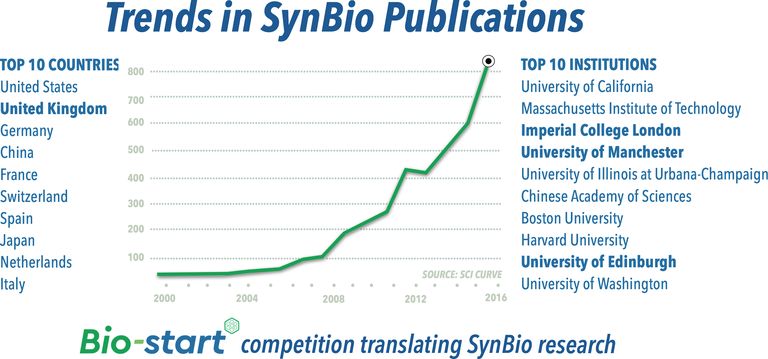Synthetic Biology Publications: Top Ten
- Posted on 20 September, 2016

Synthetic biology first entered the scientific lexicon in 1970s in the wake of the then recent developments in recombinant DNA technology when Waclaw Szybalski[i][ii] proposed a “new era of synthetic biology” ‘referencing ‘modules’, ‘control elements’ and ‘circuits’. The first examples of synthetic biology circuits appeared in 2000, with side-by-side papers in Nature describing bacterial cells programmed with basic circuits to create devices such as a toggle switch[iii] and biological clock[iv]. What followed has been a continuous increase in synthetic biology publications. These publications reflect the rapidly maturing of synthetic biology as an engineering discipline and its evolution from laboratory to a major driver of industrial change within the bioecomony.
Analysis on SciCurve revealed that between 1996-2016 there have been 5,254 research publications about synthetic biology. The majority of papers in this sector are from the US, with the UK in second place. The University of California leads the top ten academic institutions publishing on synthetic biology, with Massachusetts Institute of Technology in second and Imperial College London in third. Other UK academic institutions listed in the top ten are University of Manchester and University of Edinburgh.
The UK is at the forefront of global research in synthetic biology and is ranked only behind the US for the numbers of scientific papers published in the sector. The challenge ahead for the UK is to translate these research outputs into commercial opportunities. In response, SynbiCITE and the Rainbow Seed Fund have joined together to create Bio-Start, a competition designed to help facilitate early stage commercialization of synthetic biology in the UK.
Competition details can be found at www.bio-start.uk
[i] Wacław Szybalski, In Vivo and in Vitro Initiation of Transcription, Page 405. In: A. Kohn and A. Shatkay (Eds.), Control of Gene Expression, pp. 23–4, and Discussion pp. 404–5 (Szybalski's concept of Synthetic Biology), 411–2, 415–7. New York: Plenum Press, 1974.
[ii] Szybalski, W; Skalka, A (1978). "Nobel prizes and restriction enzymes". Gene. 4 (3): 181–2.
[iii] Collins, James J.; Gardner, Timothy S.; Cantor, Charles R. (2000). "Construction of a genetic toggle switch in Escherichia coli". Nature. 403 (6767): 339–342.
[iv] Elowitz, Michael B.; Leibler, Stanislas (2000). "A synthetic oscillatory network of transcriptional regulators". Nature. 403 (6767): 335–338.
Share this article:
